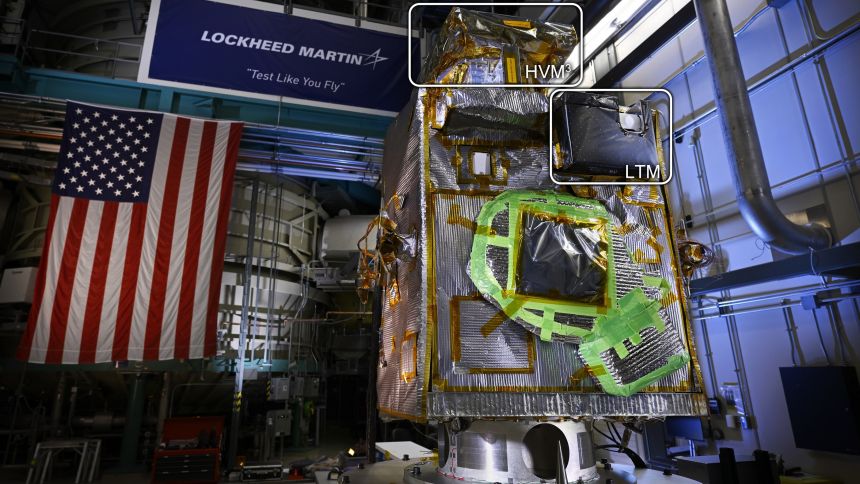A thermal imaging camera built by the University of Oxford's Department of Physics will form an integral part of NASA's Lunar Trailblazer mission, scheduled to launch in 2024. This aims to map the distribution of the different forms of water on the surface of the Moon to better understand the lunar water cycle and inform future human missions.
The Lunar Trailblazer mission will improve our understanding of our natural satellite and how we could harness its resources to support exploration in the future. Backing missions and capabilities that will drive opportunities for humanity to venture deeper into space is one of our priorities at the UK Space Agency, so it's exciting to see the instrument finally ready and fitted for take-off after years of hard work by the team at Oxford.
Libby Jackson, Head of Space Exploration at the UK Space Agency
The University of Oxford's Lunar Thermal Mapper (LTM) instrument has passed an important milestone on its journey to the Moon, with its recent installation on NASA's Lunar Trailblazer spacecraft at Lockheed Martin Space in Colorado, USA.
The cutting-edge camera, supported by the UK Space Agency, will map the surface temperature and composition of the lunar surface at a resolution of around 50 metres. In combination with the spacecraft's High-resolution Volatiles and Minerals Moon Mapper (HVM3), this will help scientists to determine the abundance, location, and form of the Moon's water.
Both instruments have now been installed on the Lunar Trailblazer spacecraft: a small satellite measuring only 3.5 meters wide with its solar panels fully deployed. This will search for evidence of water on the lunar surface to provide maps to guide future robotic and human explorers, including the Artemis program's human landings. Water on the Moon could be used in a variety of ways, from purifying it as drinking water to processing it for fuel and breathable oxygen.
The LTM will use four broadband infrared channels to provide maps of the lunar surface temperature ranging from approximately -163°C to 127°C. The instrument will also use eleven narrow infrared channels to map small variations in the composition of silicate minerals that make up the rocks and soils of the Moon's surface. This will provide more information about what the lunar surface is made of and where water may potentially be found. Meanwhile, the HVM3 (built by NASA's Jet Propulsion Laboratory in Southern California) will detect and map the form, abundance, and locations of water over the lunar landscape by measuring spectral fingerprints (wavelengths of reflected sunlight).
 The Lunar Thermal Mapper wrapped in a multilayer insulation blanket. Credit: University of Oxford for Lunar Trailblazer.
The Lunar Thermal Mapper wrapped in a multilayer insulation blanket. Credit: University of Oxford for Lunar Trailblazer.By measuring the same locations at different times of day, Lunar Trailblazer will be able to detect if the amount of water changes on this airless body, for instance, by transforming into a gas as the surface heats up, or accumulating like frost in the shadowed regions as the surface cools down. The mission will help answer key questions such as whether water molecules might be locked up inside lunar rock, or if the permanently shadowed craters at the lunar poles hold significant quantities of water ice.
Lunar Trailblazer was selected by NASA's Small Innovative Missions for Planetary Exploration (SIMPLEx) program in 2019: a competition to propose future small satellite missions. Lunar Trailblazer will launch as a secondary payload on a planned lunar lander mission led by Intuitive Machines, effectively hitchhiking on the larger spacecraft. This is expected to launch in 2024.
Professor Neil Bowles, Instrument Scientist for LTM at the University of Oxford's Department of Physics, said: 'Designing, building, testing and now delivering LTM for its trip to the Moon is a fantastic example of the innovative and dedicated teams at Oxford and across the UK, especially given the challenges of the recent pandemic. The data from the mission will help us to understand how water is transported across the surface and potentially captured in cold traps near the lunar poles, allowing follow-up from future human robotic exploration.'
For the Planetary Experiments Group at the University of Oxford's Department of Physics, building the LTM is the latest achievement in a 50-year history of developing components for spaceflight and infrared thermal mapping cameras, including for missions to Mars, Saturn, and the Moon. In 2014, the department built and launched a small infrared thermal camera as part of the UK spacecraft TechDemoSat-1, to test technologies that could help create thermal maps of asteroids. Building on this previous experience meant that the Oxford team were strongly placed to propose an updated thermal camera for Lunar Trailblazer.
 The Lunar Trailblazer spacecraft, minus solar panels. The High-resolution Volatiles and Minerals Moon Mapper (HVM3) science instrument is located atop the spacecraft. The Lunar Thermal Mapper (LTM) is the black rectangle attached to the upper right of the spacecraft's body. Credit: Lockheed Martin Space
The Lunar Trailblazer spacecraft, minus solar panels. The High-resolution Volatiles and Minerals Moon Mapper (HVM3) science instrument is located atop the spacecraft. The Lunar Thermal Mapper (LTM) is the black rectangle attached to the upper right of the spacecraft's body. Credit: Lockheed Martin SpaceFurther information can be found on the Lunar Trailblazer Mission website.
The Lunar Trailblazer mission is led by Principal Investigator Professor Bethany Ehlmann at the California Institute of Technology (Caltech) and managed by NASA's Jet Propulsion Laboratory in Southern California. The LTM was designed, built, and tested by the Department of Physics, University of Oxford, with optics manufactured by Durham University's Centre for Advanced Instrumentation and far infrared filters supplied by the University of Cardiff and specialist manufacturers based across the UK. Support for electronics and software design early in the project was provided by RAL Space.






